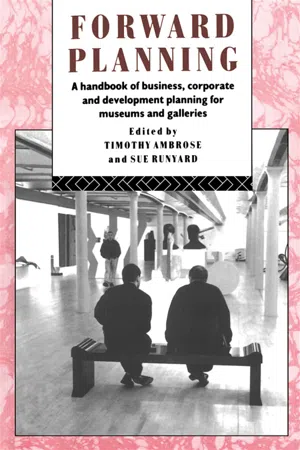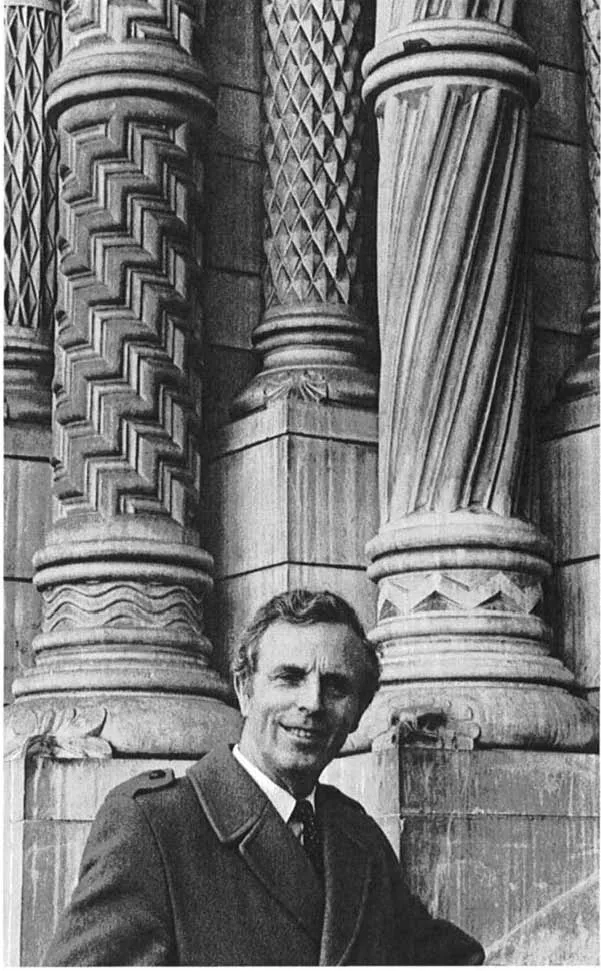
eBook - ePub
Forward Planning
A Handbook of Business, Corporate and Development Planning for Museums and Galleries
- 184 pages
- English
- ePUB (mobile friendly)
- Available on iOS & Android
eBook - ePub
Forward Planning
A Handbook of Business, Corporate and Development Planning for Museums and Galleries
About this book
Forward planning is esential for most organizations, but especially so for museums and heritage bodies, with responsibilities stretching forward to infinity. Forwrd Planning provides a complete basic guide, from the principles on which planning is founded, through drawing up the plan itself, implementation and monitoring, through to the wider potentials that good planning permits. All the contibutors to the book speak from wide practical experience. A full bibliography and suggestions for further reading are included.
Frequently asked questions
Yes, you can cancel anytime from the Subscription tab in your account settings on the Perlego website. Your subscription will stay active until the end of your current billing period. Learn how to cancel your subscription.
At the moment all of our mobile-responsive ePub books are available to download via the app. Most of our PDFs are also available to download and we're working on making the final remaining ones downloadable now. Learn more here.
Perlego offers two plans: Essential and Complete
- Essential is ideal for learners and professionals who enjoy exploring a wide range of subjects. Access the Essential Library with 800,000+ trusted titles and best-sellers across business, personal growth, and the humanities. Includes unlimited reading time and Standard Read Aloud voice.
- Complete: Perfect for advanced learners and researchers needing full, unrestricted access. Unlock 1.4M+ books across hundreds of subjects, including academic and specialized titles. The Complete Plan also includes advanced features like Premium Read Aloud and Research Assistant.
We are an online textbook subscription service, where you can get access to an entire online library for less than the price of a single book per month. With over 1 million books across 1000+ topics, we’ve got you covered! Learn more here.
Look out for the read-aloud symbol on your next book to see if you can listen to it. The read-aloud tool reads text aloud for you, highlighting the text as it is being read. You can pause it, speed it up and slow it down. Learn more here.
Yes! You can use the Perlego app on both iOS or Android devices to read anytime, anywhere — even offline. Perfect for commutes or when you’re on the go.
Please note we cannot support devices running on iOS 13 and Android 7 or earlier. Learn more about using the app.
Please note we cannot support devices running on iOS 13 and Android 7 or earlier. Learn more about using the app.
Yes, you can access Forward Planning by Timothy Ambrose,Sue Runyard in PDF and/or ePUB format, as well as other popular books in Business & Museum Administration. We have over one million books available in our catalogue for you to explore.
Information
III
Forward planning inspecialist areas
10
Collections care and its costs
Gail Lord
Independent Consultant
A study carried out by our organisation1 used a variety of quantitative methodologies to identify the categories of costs which can be attributed to collections management. We found it useful to distinguish between the direct and indirect costs of collecting, and this is a distinction which the curator needs to be aware of in the planning process.
The direct costs of collecting in museums amount to 38 per cent of operating costs. This figure breaks down as follows (per cent):
Security
14
Curatorial programmes
13
Documentation
4
Conservation
4
Research
2
Stock taking
1
The indirect costs associated with museum collections cover general maintenance and administration. On average, UK museums have 80 per cent of their collections in storage and 20 per cent on display. Combined, these collections occupy about 64 per cent of museum space. Utilising survey data and other data sources, it can be estimated that the indirect costs of collecting amount to about 28 per cent of the museum running costs.
Factors influencing the costs of collecting
Forward planning is concerned with allocation of resources to achieve agreed goals and objectives. Failure to attend to factors that influence the costs of collecting can result in squandering scarce resources.
The two main factors are the condition of the collection and the condition of the building which houses it. These are interdependent variables since poor environmental conditions necessitate repeated remedial conservation treatment. The implication for the majority of UK museums is the need to plan and implement a capital renewal programme with preventive conservation as its focus. In this context, the sections on conservation and environmental control may be found useful.
The framework of costs
Our study proposes a framework of costs which would be useful to the forward planner in projecting collection management related costs:
(a) The initial costs of acquisition
purchase price (if any)
curatorial costs
documentation cost
conservation cost
cost of providing storage
purchase price (if any)
curatorial costs
documentation cost
conservation cost
cost of providing storage
(b) The direct and indirect operating costs for collections managementand care
These have been detailed above, and in the study survey averaged about £120 per square metre of museum space.
These have been detailed above, and in the study survey averaged about £120 per square metre of museum space.
(c) The ‘capitalised cost of collecting’
This allows the forward planner to evaluate the opportunity costs of acquisitions. For example, an object requiring 1 square metre of storage space requires a capital investment of the acquisition costs listed in A above, plus an endowment of roughly £1,200 which (at an annual interest of 10 per cent) would yield £120 per year to cover the annual running cost referred to in B above.
This allows the forward planner to evaluate the opportunity costs of acquisitions. For example, an object requiring 1 square metre of storage space requires a capital investment of the acquisition costs listed in A above, plus an endowment of roughly £1,200 which (at an annual interest of 10 per cent) would yield £120 per year to cover the annual running cost referred to in B above.

Gail Lord
Planning strategies
It is becoming more widely understood that museums are underfunded relative to the real costs of collecting and the growing value of collections. A detailed knowledge of the cost of collecting in each specific museum can lead to practical forward plans that address future needs. These forward plans should utilise capital improvements as a strategy to reduce long-term running costs; establish endowment funds to help meet the growing operational costs of collecting; develop new approaches to the solicitation of donations so that some of the real costs of collecting can be met at the point of acquisition; and make the case for realistic core funding for the museum’s main function, the preservation of collections for future generations.
Note
1 Gail and Barry Lord and W.John Nicks, The Cost of Collecting:Collection Management in UK Museums, HMSO, 1989.
11
Maintenance
Ron Essex
Estate Manager, Natural History Museum
Adequacy of funding for maintenance has always been a contentious issue, with some authorities seeing maintenance as an area where reduction in funding is always possible when pressures elsewhere get high, or simply when other demands become more attractive to them. Maintenance managers invariably feel that provision is never sufficient for their needs. Who is right?
The art of achieving a sensible balance between over- and underfunding maintenance is one that requires experience and a clear understanding of the risks involved in order to achieve the optimum level required.
There are a number of good publications providing advice on this and explaining the processes involved in managing the maintenance of large estates. Three areas of advice are common. They may be summarised as:
- know your estate
- identify and programme its maintenance needs
- calculate and plan resources to meet those needs (budgeting).
To ignore any one of these areas leaves the manager in a weak position. When making a case for sensible funding, all are necessary and interact with each other.
Knowing your estate means having to hand all the information about it, e.g. drawings giving details of building construction, layout, floor areas, plant and equipment schedules with servicing requirements, copies of lease conditions, etc. Should any part of the information be missing, then it is essential to devote time to obtaining it. Trying to manage maintenance without such basic data is like trying to steer a boat without a rudder— you can very easily lose direction.
Identifying maintenance needs is achieved mainly through inspection. This is particularly true for buildings and static mechanical and electrical installations. Potential deficiencies are obvious to the trained eye. In the case of moving plant and equipment, maintenance can be based more on servicing needs related to the amount of use each item receives, for which manufacturers usually make recommendations. Nothing, of course, lasts forever, and replacement must be considered at some time in the future, usually when maintenance costs become uneconomic. However, one should not forget that upgrading to improve efficiency is also an option worth considering.
Once all the maintenance needs have been identified, they should be listed in the order in which they should be carried out, and programmed over a period of, say, five years. Some items will be of a cyclical nature and will repeat themselves at regular intervals (e.g. redecoration), while others will be irregular in pattern (e.g. replacing roof coverings) and technical judgement will be needed to decide when. Programming work in this way enables its cost to be spread more evenly over time, and gives early warning of major expenditure peaks. It also ensures that valuable resources are directed to the work in the correct order of priority, allowing the ‘stitch in time’ principle to operate where practical in order to reduce overall costs.
When assessing priorities, consideration should be given to the work in the following order:
- Work to rectify defects affecting health and safety of staff and visitors.
- Work needed to comply with statutory requirements.
- Work required to maintain buildings wind- and weather-tight or to prevent serious deterioration to the structure or the mechanical and electrical services.
- Work to maintain or improve operational efficiency or staff morale.
- Work of a cosmetic nature.

Ron Essex
Programmes should be reviewed as often as is necessary to take account of changes in circumstances or improved information. They should be continued through time, because year 2 and subsequent years eventually become year 1. The judgements made for future years’ work should also be reassessed, confirmed or amended as those years approach the beginning of the cycle.
The current year’s maintenance programme may be adjusted if necessary to fund an unscheduled high priority, by simply rescheduling the lowest priority forward into year 2, provided no commitment has been made at the time the need is identified. Similarly, work can be rescheduled from year 2 into year 1 should additional funds become available, provided there is adequate time left in the year to plan and execute it.
The process of calculating the overall financial resources needed for maintenance (e.g. submitting a budget bid for funds to complete the programme) cannot be treated in isolation from the programming process outlined above. It is an essential part of it, and necessary in order to make sensible judgements to obtain the desired even spread of expenditure. However, the cost estimates needed for the individual packages of work making up the budget bid need to be properly assessed and cannot rely on pure guesswork based on inspiration and little else.
Whilst such estimates need to be reasonable assessments of the cost involved, they do not need to be accurate in detail at budget stage. The methods used should therefore reflect this. The following methods are suitable for the purpose:
- Historic cost data. These can be used where the cost of similar work carried out in the past is known. Such data will need to be updated for inflation and adjusted to take account of changes in circumstances and variation in the scope or quantity of the content.
- Contractor/consultant guide prices. Contractors and consultants are often willing to provide ‘order of cost’ estimates for budgeting purposes. If this is accepted, then the fullest details of the requirement must be given together with any known restrictions (e.g. limited access or working time). Considerable distortion between the estimate given and the final tenders for the work will otherwise arise.
- Pricing books. These are useful in providing prices for work that can be quantified in reasonable detail at the budget stage. However, it is important when using such books to read carefully and understand the basis on which the prices given are calculated and to make allowances where they differ from the case being considered. Suitable books are listed in Further reading.
Further reading
Architects & Builders Price Book (Spon, annual).
Building Maintenance Price Book (Building Maintenance Information Ltd, annual).
Estimating Handbook for Building Maintenance (based on ‘Schedule of Rates for Building Works 1985’; PSA/DBQSS).
Mechanical & Electrical Services Price Book (Spon,annual).
12
Developments in financialmanagement
Jeffrey Defries
Assistant Director, National Museum of Science & Industry
Planning is about resource levels and utilisation. Money is both a key resource in its own right and also a means of quantifying other resources. Financial management concerns the planned utilisation of money, including other resources measured in money terms, in order to meet corporate objectives themselves expressed through the planning process. It is necessarily a forward-looking discipline, although its traditionally most well-understood application— accounting—has significant responsibilities for the accurate reporting of past activity and the establishment of a framework for current activity.
Financial management in museums
Museums have tended to be adept at financial administration, including the operation of rules and regulations, but less capable of financial management. Thus, financial accounting is normally of the receipts and payments (cash accounting) type, which might satisfy central or local government requirements but does little to evaluate performance against targets or to present the true financial position of the institution. The introduction of income and expenditure (accruals) accounting is essential if museums are to measure the success of planning and budgeting rather than to view the position at a snap-shot in time, i.e. at the end of the financial year. Gallery and building projects necessarily span financial years and the accounts must reflect this. The analysis of source and application of funds and the preparation of a balance sheet are important tools of management and serve as valuable indicators to trustees and the outside world of financial health.
The importance of budgeting control
Changes in financial accounting must be mirrored by changes in management accounting. The setting of forward budgets for the year ahead and for rolling three- or five-year periods is a vital component of corporate planning. It is the job of the budget to support the strategic objectives identified in the corporate plan. Traditionally budgets have been at worst on a last-year-plus-inflation basis and at best based on analysis o...
Table of contents
- Cover Page
- Title Page
- Copyright Page
- Acknowledgement
- Foreword
- Introduction
- I Assessing your position
- II Writing your plan
- III Forward planning inspecialist areas
- IV Using your plan
- V Samples and extracts from forward plans